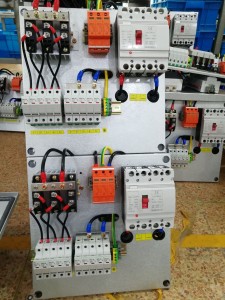Like any electronic device, solar arrays can generate voltage surges that can damage components and cripple the device. surge protection device help keep the system running.
Think of a home or office computer. In addition to desktops or laptops, there may be external monitors, speakers or even printers. Too many components couldn’t plug into the wall outlet, so most people bought a switchboard. However, the panel isn’t just a convenient way to stick a bunch of stuff into a socket. It actually helps to protect these electronics from the harmful effects of surges.
A surge, also known as a transient voltage, usually refers to a transient increase in voltage that is much higher than normal. For example, the standard voltage for a home or office is 120V. Voltage can be thought of as electrical pressure. Thus, just as too much water pressure can cause a garden hose to burst, too high a voltage can damage electronics. These surges may come from natural sources, such as lightning, as well as from the interior or peripheral equipment of the power grid.
Surge protection device help prevent damage to electronic equipment by transferring surplus power from “Hot”power lines to ground wires. In most common surge protectors, this is accomplished by metal oxide varistors (MOV) , which are metal oxides connected to power and ground wires through two semiconductors.
Solar energy needs Surge Protector
Solar panels are also electronic devices, and therefore subject to the same risks of surge damage. Solar panels are particularly vulnerable to lightning strikes because of their large surface area and their placement in exposed locations, such as on roofs or in open spaces on the ground.
Solar contractors do not always know whether they are building in an area that is prone to lightning strikes. Integrate data from the U.S. Lightning Detection Network into a free tool that allows solar contractors to evaluate the lightning hazards of their projects.
Lightning is about 50,000 ° F (five times higher than the Sun) , so it’s no surprise that it might be harmful to solar equipment. If you hit the solar panel directly, the lightning may burn holes in the device or even cause an explosion, and the entire system will be destroyed.
However, the effects of lighting and other overvoltages are not always significant. The secondary effects of these events will affect not only the primary components such as modules and inverters, but also surveillance systems, spotter controls and weather stations, Sirava said.
Lightning protection
Secondary effects are usually the least recognized dangers. PV module loss means string loss, while central inverter loss will mean power loss in most parts of the plant.

Installation of surge protector
Because all electrical equipment is simply affected by the surge, the SPD can be used for all solar array components. Industrial versions of these devices also use a combination of metal oxide varistors (MOV) and other haphazard devices to transmit surge overvoltage to the ground. As a result, SPD is generally installed after the secure grounding system is in place.
Taking into account the electrical single-line diagram of the SPD cascade from the utility service to the array equipment, with robust maintenance equipment at the primary entrance, to avoid large surge transients and smaller devices reaching device endpoints along critical paths.
SPD networks should be installed in AC and DC distribution throughout the solar array to maintain critical circuits. The SPD device shall be mounted on the DC input and AC output of the system inverter, and the positive and negative DC lines shall be grounded when grounded. AC maintenance shall be deployed on each grounded power line. The combiner circuits shall also be maintained, and all control circuits and even the surveillance and surveillance systems shall be maintained to avoid disturbance and data loss.
With regard to the system of business and utility planning, the 10m rule is recommended. For devices with DC cable length less than 10m (33ft) , the DC solar surge protection device should be located in a convenient location, such as the location of the inverter, bus box or near the solar module. For devices with DC cable length exceeding 10m, solar surge protection device shall be installed at the inverter end of the inverter and the module end of the cable.
Residential solar systems with miniature inverters have very short DC cables, but longer AC cables. The SPD mounted on the manifold can protect the house from the effects of the array surge. In addition to those surges from municipal power and other internal equipment, surge protectors on the motherboard also protect the house from array surges.
In systems of any size, SPD shall be operated by licensed electricians on the advice of the manufacturer and in accordance with installations and electrical standard installations to maximize safety and effectiveness.
Other processes can be adopted, such as adding lightning rods to further maintain solar panels from lighting.
Even the most powerful surge maintenance plan has its limitations. For example, the SPD can not avoid physical damage caused by direct lightning strikes.
This is the best thing modern science can do: surge protection device



 2021-08-25
2021-08-25















